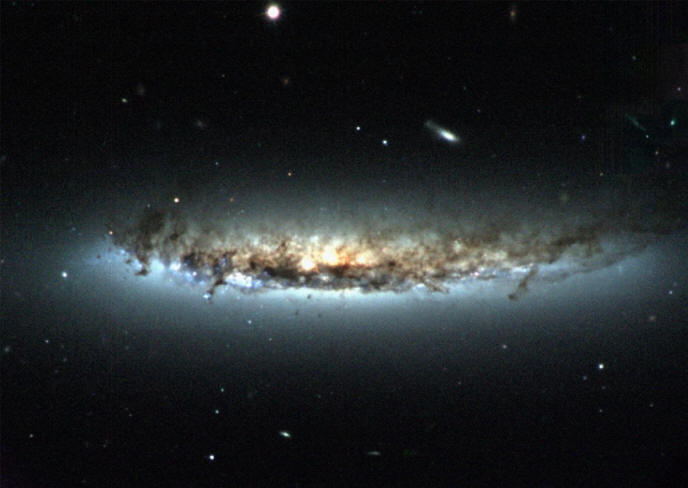|
|
|

Streaming gases in NGC 4402 distort its shape
into a bowl.
Credit: H. Crowl (Yale University) and WIYN/NOAO/AURA/NSF.
Cometary Galaxies
May
04, 2010
Some galaxies exhibit broad
tails, as well as bright comas of
gas surrounding a central nucleus.
What is a comet? An astronomer might
remark that a comet is a small,
fragile, irregularly shaped object
composed mostly of water ice and
dust, along with carbon and
silicon-based compounds. "Dirty
snowballs," as Fred Whipple
described them in 1950. Consensus
opinions continue to support the
theory after almost 60 years.
According to Whipple's proposal, as
a comet approaches the Sun the "hot"
solar wind transforms the solid
nucleus directly into a vapor
through sublimation, bypassing the
liquid phase. Material from the
nucleus begins to expand outward,
forming a cloud of gas and dust
otherwise known as the coma.
Sunlight and the solar wind interact
with the cloud to form a long tail.
However, ask an Electric Universe
advocate what a comet is and a
different answer will be
forthcoming.
Comets spend most of their time far
from the Sun where the charge
density is low. Since comets move
slowly, their electric charges reach
equilibrium with the weak, radial
solar electric field. When a comet
falls in to the inner Solar System
closer to the Sun, however, its
nucleus accelerates into regions of
increasing charge density and
varying electrical flux.
Polarity and charge characteristics
in the nucleus respond to the
increasing solar forces, forming a
coma (charge sheath) around it.
Discharge jets flare up and move
across the surface very much like
the plumes of Jupiter's moon, Io. If
the internal charge imbalance
becomes too great, the nucleus may
explode like an overcharged
capacitor, breaking into fragments
or vanishing forever. Similar
effects are most likely responsible
for meteoric explosions in Earth's
atmosphere, such as the one that
occurred over Tunguska in Siberia.
Surprisingly, a
recent article describing the
Hubble Space Telescope repair
mission highlights two different
galaxies within the Virgo Cluster
that seem to exhibit comet-like
characteristics.
As NGC 4522 and NGC 4402 move
through the intergalactic medium,
they are being distorted by "strong
winds." Astrophysicists say that the
galaxies are plowing through gas and
dust, so are experiencing "ram
pressure." On Earth, ram pressure is
known as "drag," and results from
air friction.
In the case of the Virgo Cluster,
researchers suggest that its mass of
hot gas and dust is acting in the
same way, forcing the material in
both galaxies back against their
apparent motion and causing them to
form comas and tails, as well as a
distinct rounding of their forms in
the direction of travel.
Another galaxy cluster,
Abell 2667 contains a galaxy
that is also undergoing "ram
pressure stripping" of its
structure. In fact, it has been
named "The
Comet Galaxy." According to
Jean-Paul Kneib from the Laboratoire
d'Astrophysique de Marseille:
"This unique galaxy, situated 3.2
billion light-years from Earth, has
an extended stream of bright blue
knots and diffuse wisps of young
stars driven away by the tidal
forces and the ‘ram pressure
stripping’ of the hot dense gas."
In past Picture of the Day articles,
shock waves, hot gas, and collisions
in deep space have been discussed.
They are often used to describe the
phenomena that create high-frequency
electromagnetic radiation in the
cosmos. From gamma rays down through
x-rays and extreme ultraviolet,
conventional theories have relied
upon gravity and acceleration as the
only way for them to be produced in
space.
In other words, kinetic energy
alone, without recourse to
electrical explanations, is
responsible for what we see and
detect with our instruments. This
situation is born from the
gravity-only theory of cosmic
evolution.
Since comets hold a highly negative
charge, they attract the positively
charged solar wind ions,
accumulating an immense envelope of
ionized hydrogen, up to millions of
miles across. Perhaps galaxies
embedded within their clusters
experience something similar.
Perhaps cluster cores generate
significant streams of charged
particles that flow outward much
like the solar wind.
If galaxies within a cluster are
oppositely charged from the cluster
core, the core will pull them in
toward the region of greatest charge
density: they will experience
"anomalous velocity." If there are
regions of charge separation within
a galaxy (such as NGC 4522 or its
companion), then the material that
is the same polarity as the cluster
core will be blown back and away,
again much like the coma and tail of
a comet in the Solar System.
Electrical connections exist
throughout the Universe. From the
smallest scale atomic interactions
to the largest scale cosmic
conglomerations, electricity
provides the power and demonstrates
its activity in plain sight.
Stephen Smith
|
|
|
|
|
|
|
|
|
YouTube video, first glimpses of Episode Two in the "Symbols of an Alien Sky"
series.
|
|
|
|
|
|
|
Three ebooks in the Universe Electric series are
now available. Consistently
praised for easily understandable text and exquisite graphics.
|
|
|
|
|
|
|
|
|
|







